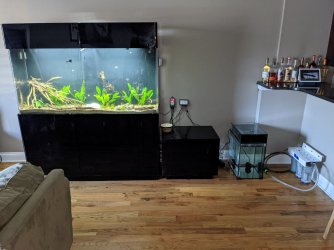Here was my solution to saying screw buckets.
My setup went as follows.
Equipment
X1 Neptune FFM ATK ( I chose this because I plan to move to an Apex controller at some point. But any ATK system should be fine I'm sure. )
X1 LiterMeter III 3 stage pump ( its older, and I'm sure there are better options on the market today. But it can move a pretty large amount of water in a day, pretty quietly. I had it moving 30 gallons a day in and out of my 150 gallon a little bit back when I had to treat for Ick )
X1 15 gallon reservoir. I bought mine, but you can build one easily enough.
X2 Kaomer X1 Bluetooth Microdoser. ( I don't like these pumps, as they do not remember their programming if the power gets reset )
X1 3 way Osmosis kit with long hoses.
A lot of hosing.
My literMeter has 2 pumps hooked up to it currently. All of my water gets pumped in / out of my sump under the tank.
1 pump has a hose into the sump, and then empties into a nearby sink I was able to route the hose to the sink somewhat discreetly.
1 pump has a hose in the sump, and the other end pulls from the 15 gallon reservoir next to the tank.
I generally set the amount I pump back into the tank 2 liters less per day than I pump out of the tank. So if I add 8 liters a day, I remove 10 liters a day. The water level in the sump will gradually lower below the ATK's activation level, and fill the sump back up. I set the amount I pump into the tank lower than the amount I take out so that, if over time, the flow rates get off just a little, it wont overfill my sump.
I use one microdoser to add water conditioner to the reservoir, and one adds plant food to the sump.
I have to manually add the water atm to the reservoir until I can do a little more handy work. I just have to screw the Osmosis kit hose into the sink and turn the water on. And then pay attention to make sure I don't overflow the reservoir.
I want to install a Y valve under the sink so I can just divert water. Pretty sure I can use a little robot called a PushBot ( a popular home automation robot ) to move the switch back and forth for me. Then ill move the Osmosis kit under the sink, and just have a hose that comes out of a hole I drill right in the corner below the booze.
Then I can just measure the flow rate of the water. Figure out how much the flow rate is and how long it takes to fill up the reservoir, and then automate a routine in google home to just turn the water for it on at a specific time, based on the amount i have going in and out of the tank on a daily basis.


